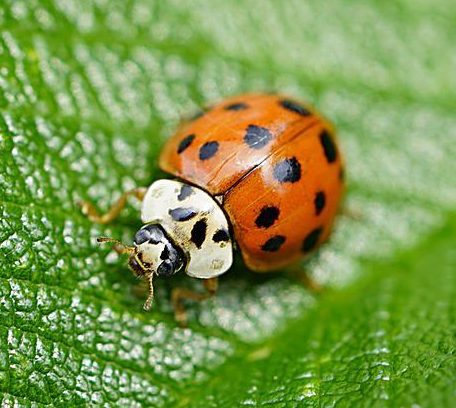The mature life span of a ladybug is around one year. They have a difficult larval stage as well as a pupal stage, which together may be regarded as an additional amount of time throughout the course of their lives. However, these early stages are over rather quickly, taking just around two months to complete.
The capacity and inclination of a ladybug to hibernate during the winter months can have an impact on the length of its lifespan. If the temperature is lower than 50 degrees Fahrenheit, ladybugs will not venture into the air. The stored fat and food ingredients that ladybugs have can sustain them through the winter if they chose to hibernate for the season.
It should come as no surprise that many other kinds of creatures, including birds and other kinds of bugs, eat ladybugs. However, they are equipped with a wide variety of one-of-a-kind protection mechanisms, such as lowering their heads and emitting an offensive odor if they feel scared when they perceive danger.

Can ladybugs survive indoors?
If capturing a ladybug and keeping it as a pet is something you’re looking forward to doing, then you might be interested in finding out how long your new companion will stay by your side.
In spite of the fact that ladybugs could appear to be fragile insects, these beetles are strong and tenacious creatures who are able to endure a broad variety of challenges posed by their natural surroundings. It is possible for lady beetles to survive for up to two years if they are carefully cared for and given the appropriate nutrition. The typical lifespan of a ladybug is around one year. However, in order to keep your new pet ladybugs healthy for an extended period of time while they are under your care, you will need to pay attention to a number of details and put in some work to construct an environment that is suitable for them.
Therefore, despite their adorable appearance, ladybugs should be kept outside of the house. They are not designed to live indoors and are more likely to perish due to exposure to the elements at your windows than they are to consume the insects that are found on your houseplants.

Figure: Ladybug on flower (https://pixabay.com/photos/ladybug-flower-meadow-nature-flora-7273814)
How long can a ladybug live in my house?
The typical lifespan of a ladybug is one year. However, during this time period, the website for home remodeling warns that they will lay thousands of eggs and swiftly increase.
How do you know how old ladybugs are?
There is no way to determine the age of a ladybug. We only know that they survive for around one year at a time. Because their lifecycle progresses through phases so quickly, they only get to experience life for a relatively little amount of time. Although identifying ladybugs might be a challenge, these insects are quite stunning in appearance.
How do you keep ladybugs alive?
Add some pieces of cardboard that have been folded in half for the bugs to crawl on. The ladybug cage should have some little twigs and branches of plants placed throughout it. Fill the ladybug house with a damp paper towel that has been folded and placed inside. A sponge that has been well cleaned and then soaked in water can also serve the purpose of providing a supply of water for the beetles.

Can you keep a ladybug as a pet?
You should not be afraid to take one or more of these creatures into your care and bring them up as pets in your own house if you feel the need to do so. They have a low maintenance need and are simple to capture. They don’t live very long, but as far as temporary pets go, you won’t find anything cuter than a hedgehog.
How long can ladybugs stay alive in water? How do they stay alive?
It is not in ladybugs’ biological make-up to live in water, and much like every other kind of bug and living thing, they are dependent on oxygen to stay alive. Because ladybugs consume a diet that is primarily composed of protein, they are able to store a significant amount of energy within their bodies. This allows them to have an energy reserve that is capable of lasting for several hours.
As a result, these pests are able to swim for approximately an hour before they become too exhausted to continue and eventually drown. However, the primary issue is not a lack of sufficient energy to swim; rather, the issue is a shortage of sufficient oxygen.
Insects, in contrast to people, do not possess lungs; yet, in order to stay alive, these parasites need oxygen. Even though ladybugs can remain alive in an atmosphere devoid of oxygen for much longer than people can, the ladybug species as a whole would perish in little more than half an hour. If you find a ladybug in a puddle in the future, keep in mind that it is not enjoying a relaxing dip but rather suffering; thus, you should make an effort to save it by placing it on dry ground.
Is the Number of Spots on a Ladybug Related to How Long It Lives?
The number of ladybug spots and superstitions surrounding them have long intrigued scientists and curious minds alike. However, contrary to popular belief, these distinctive spots do not indicate the lifespan of a ladybug. Rather, they serve as a defense mechanism and act as a warning to predators. Ladybugs are fascinating creatures with vibrant spots, but they rely on various factors, such as habitat, nutrition, and environmental conditions, to determine their lifespan.
The whole life cycle of a ladybug?
The female ladybugs begin the life cycle by laying eggs as the first stage of the life cycle. These pests are capable of laying up to fifty eggs in a single cluster, and some studies estimate that a single lady beetle may produce up to one thousand eggs over the course of a single season. Some of the eggs that are placed in a cluster do not become fertilized and therefore do not hatch. The larvae use the eggs that do not hatch as a source of food and nourishment since eggs have a high protein content.
At this stage, depending on the type of ladybug, the larva will emerge anywhere from eight to ten days after the temperature has been maintained at an optimal level of warmth. At most cases, the female beetle will lay her eggs in a spot that has been carefully selected to guarantee that there will be an enough supply of food for the developing ladybug larvae.

After the female ladybeetle has finished depositing her eggs, she will undergo a metamorphosis, which is a change in her outward appearance. Pupation is another name for the stage of metamorphosis, which occurs after laying eggs and is characterized by a sudden shift in the organism’s appearance.

After the eggs hatch, the larvae that emerged from them develop into fully grown adult ladybugs that may survive for up to a year. As a result of the ladybug’s ability to consume up to 50 aphids and eggs daily and as many as 50,000 aphids over the course of its existence, these insects are a popular choice as pets for persons who enjoy gardening or who work in agricultural fields.









